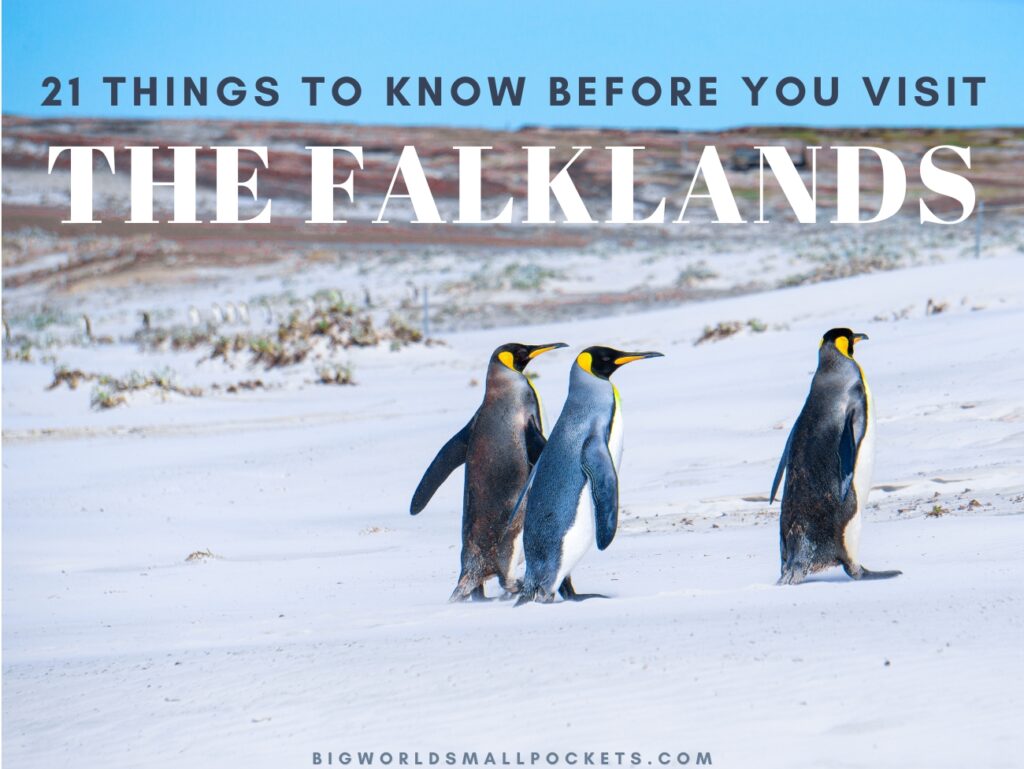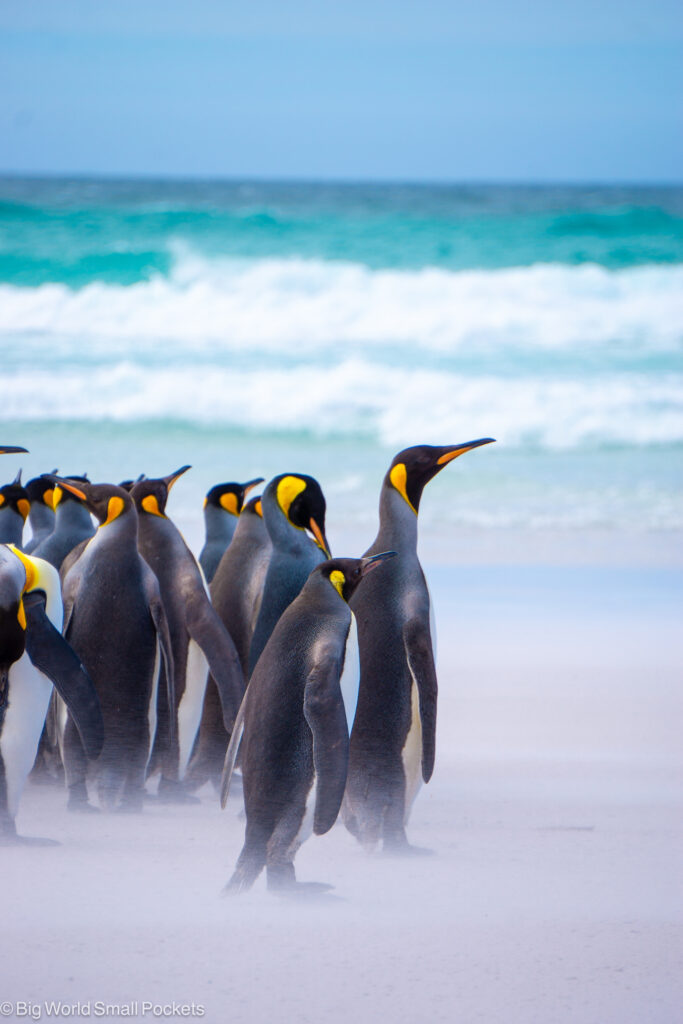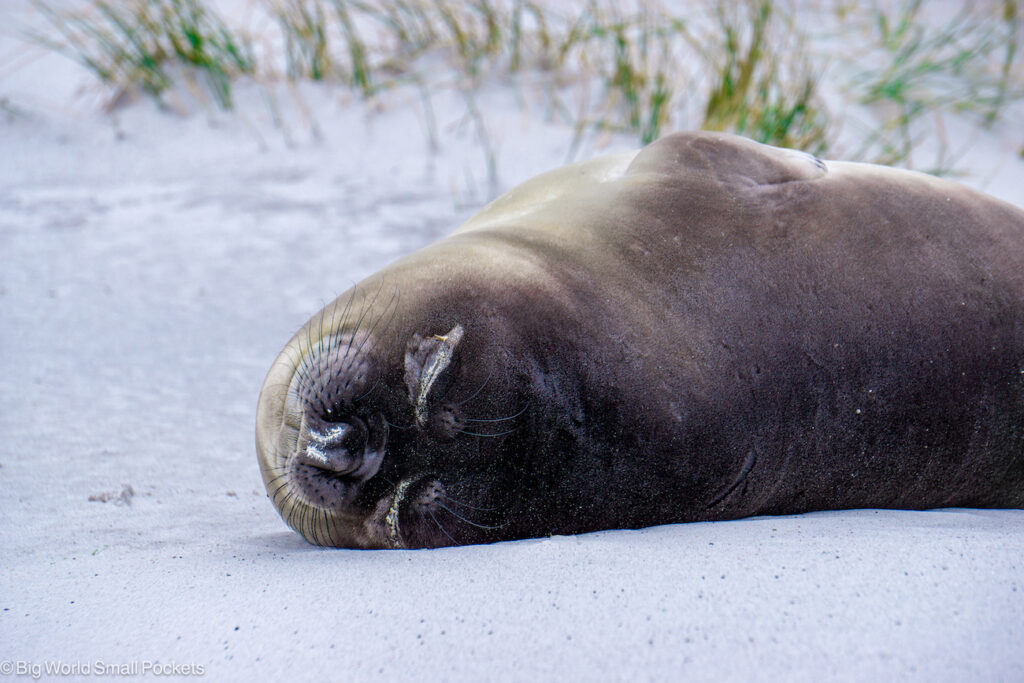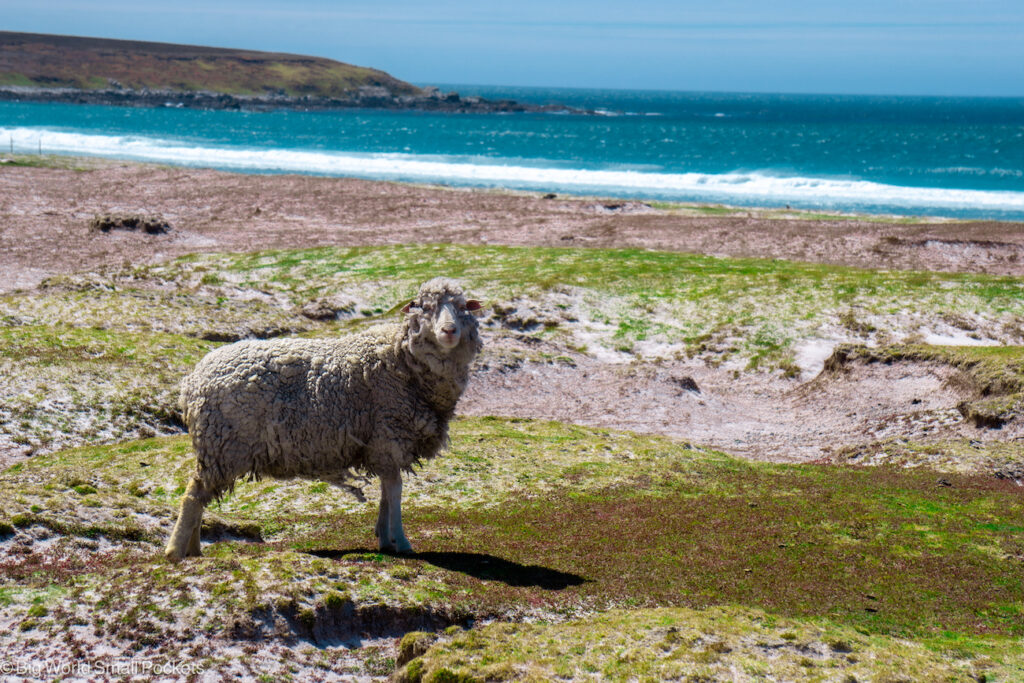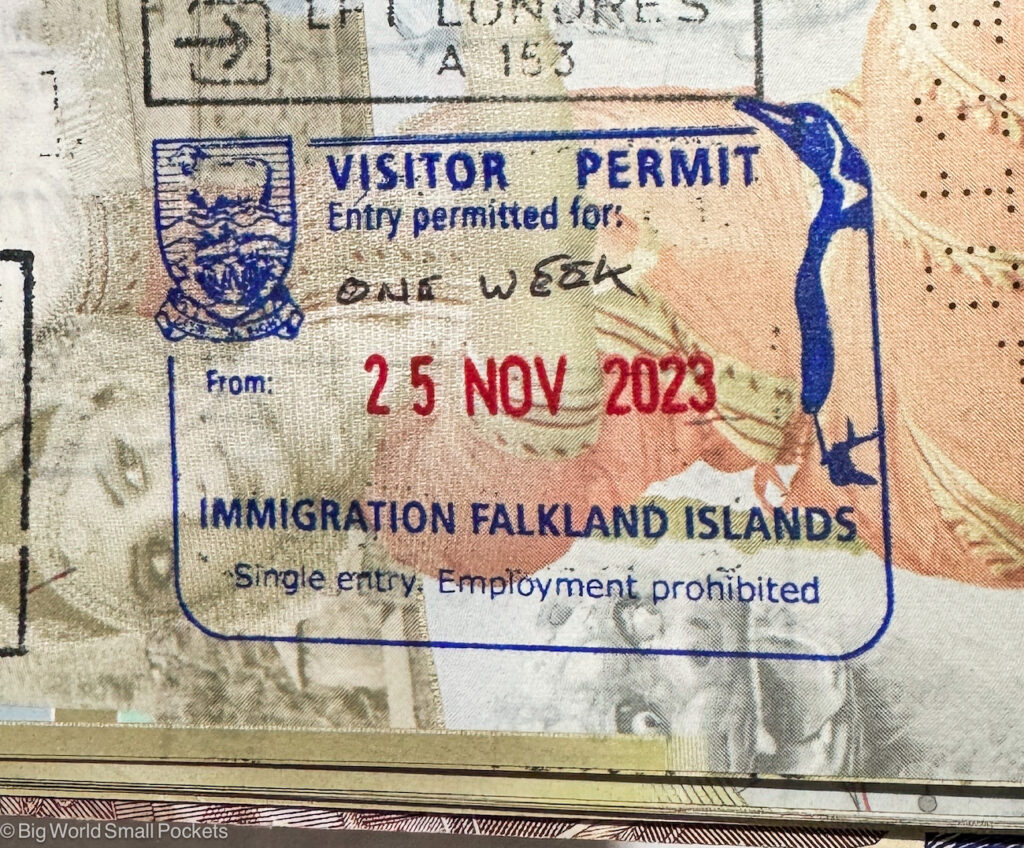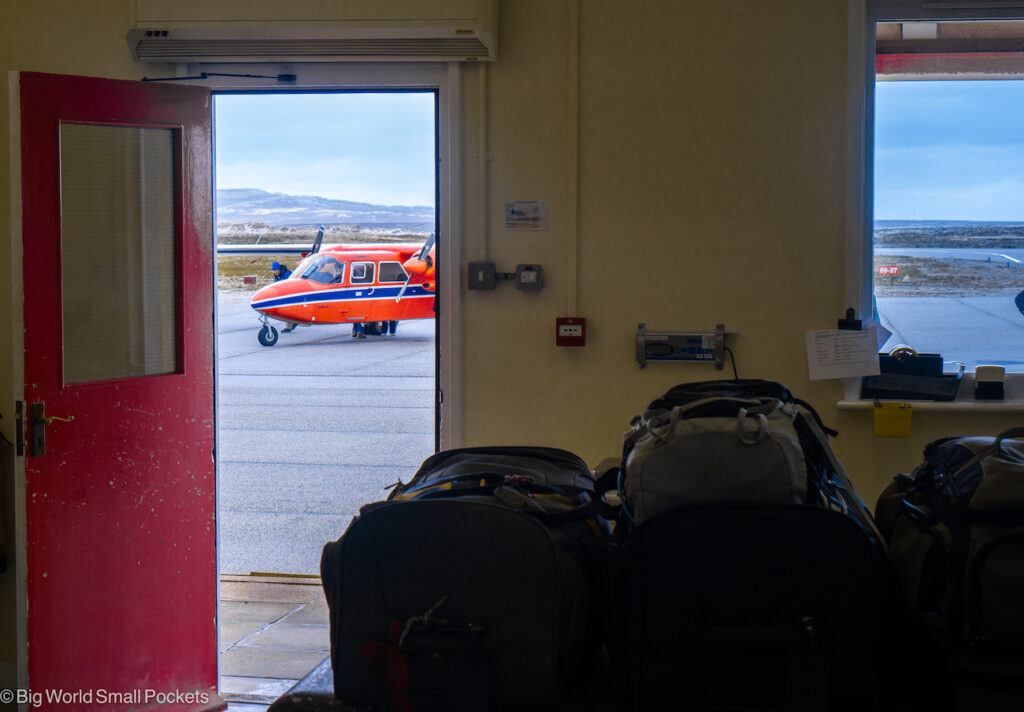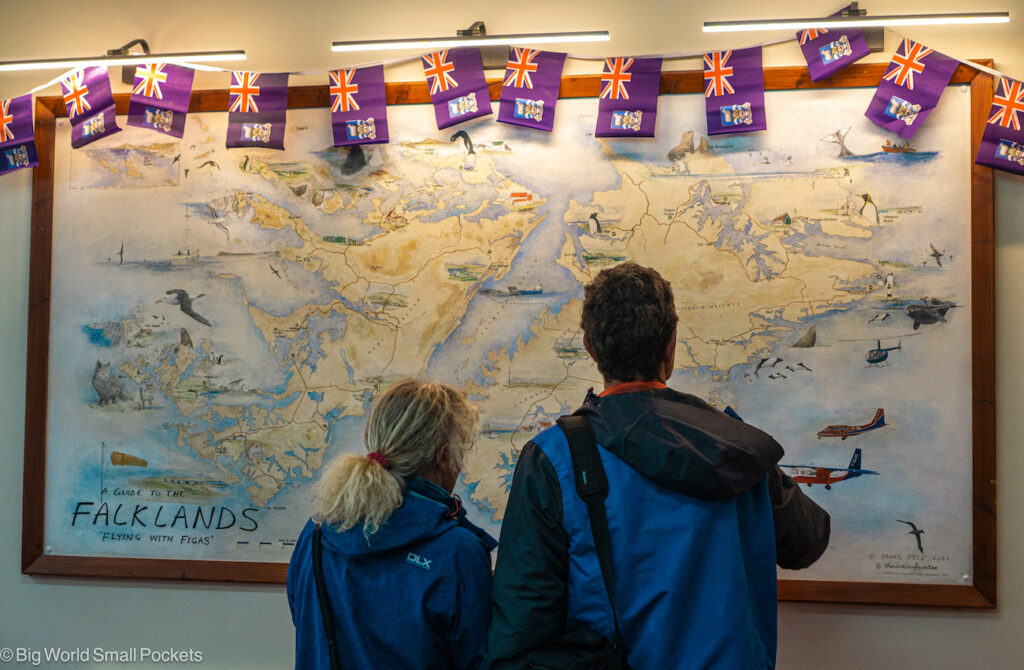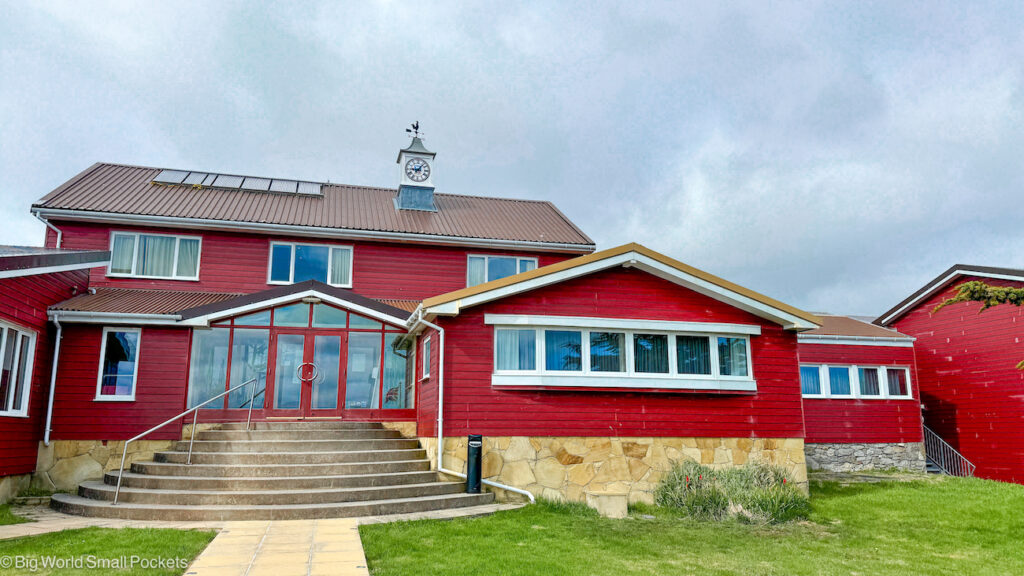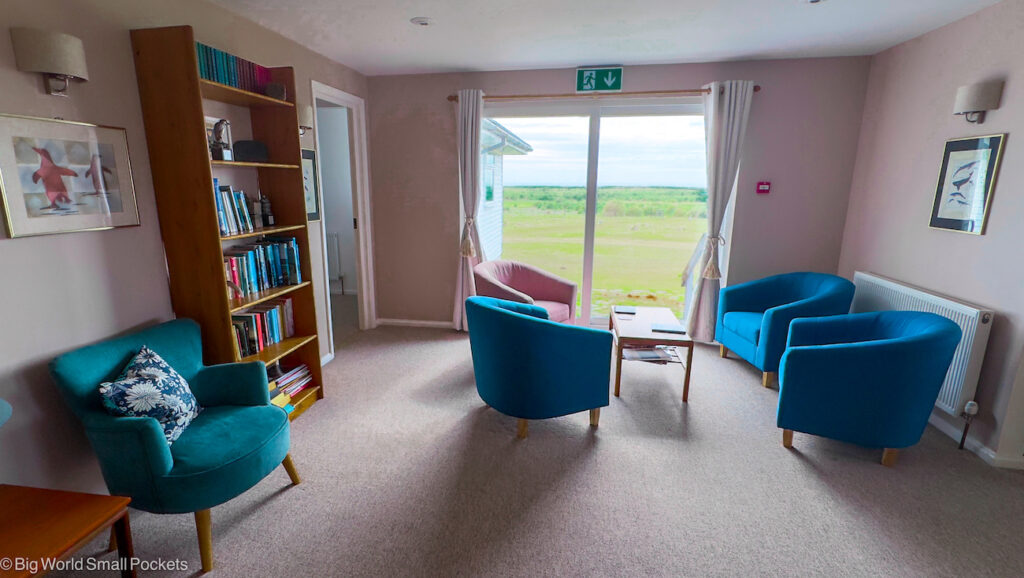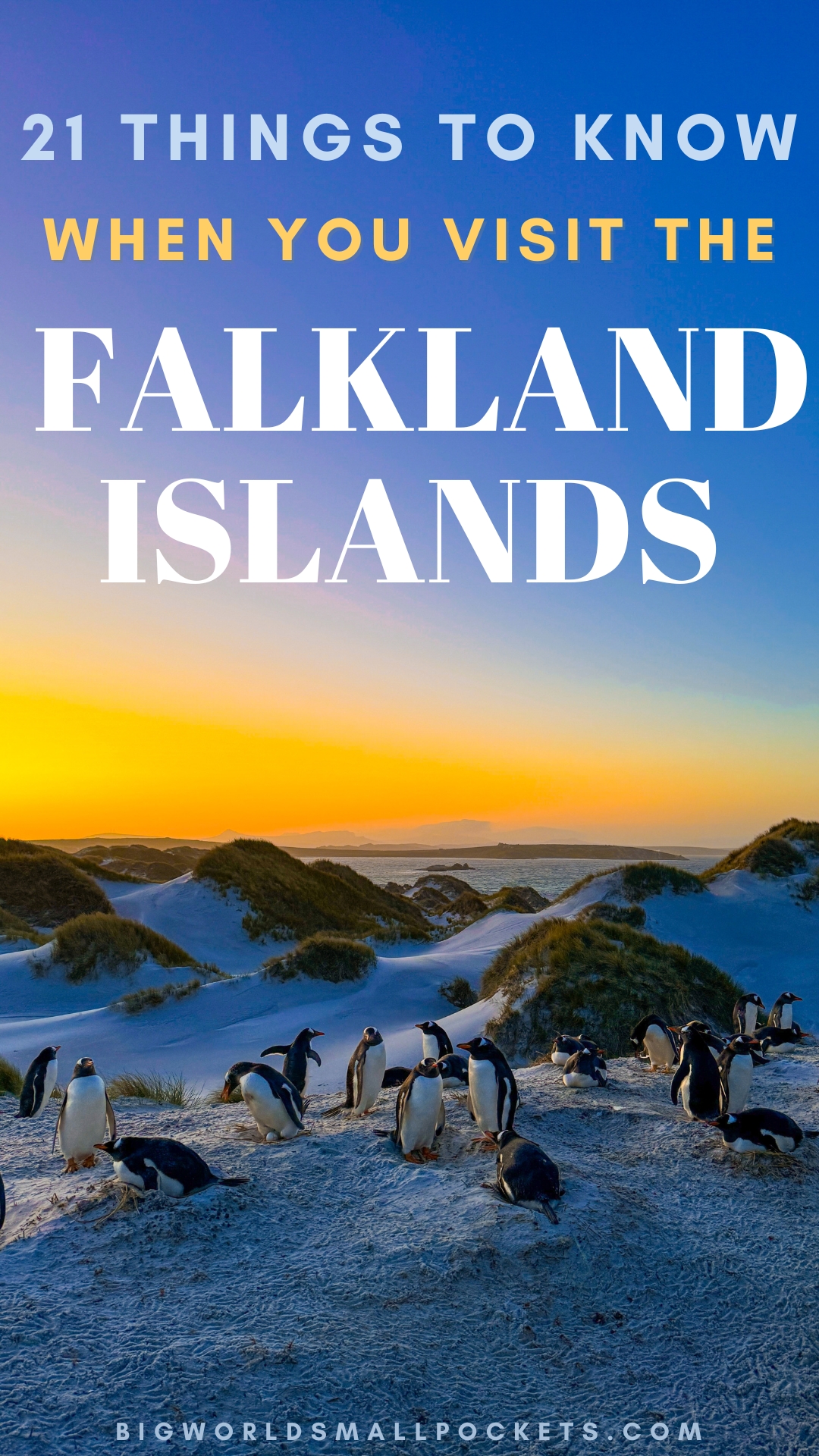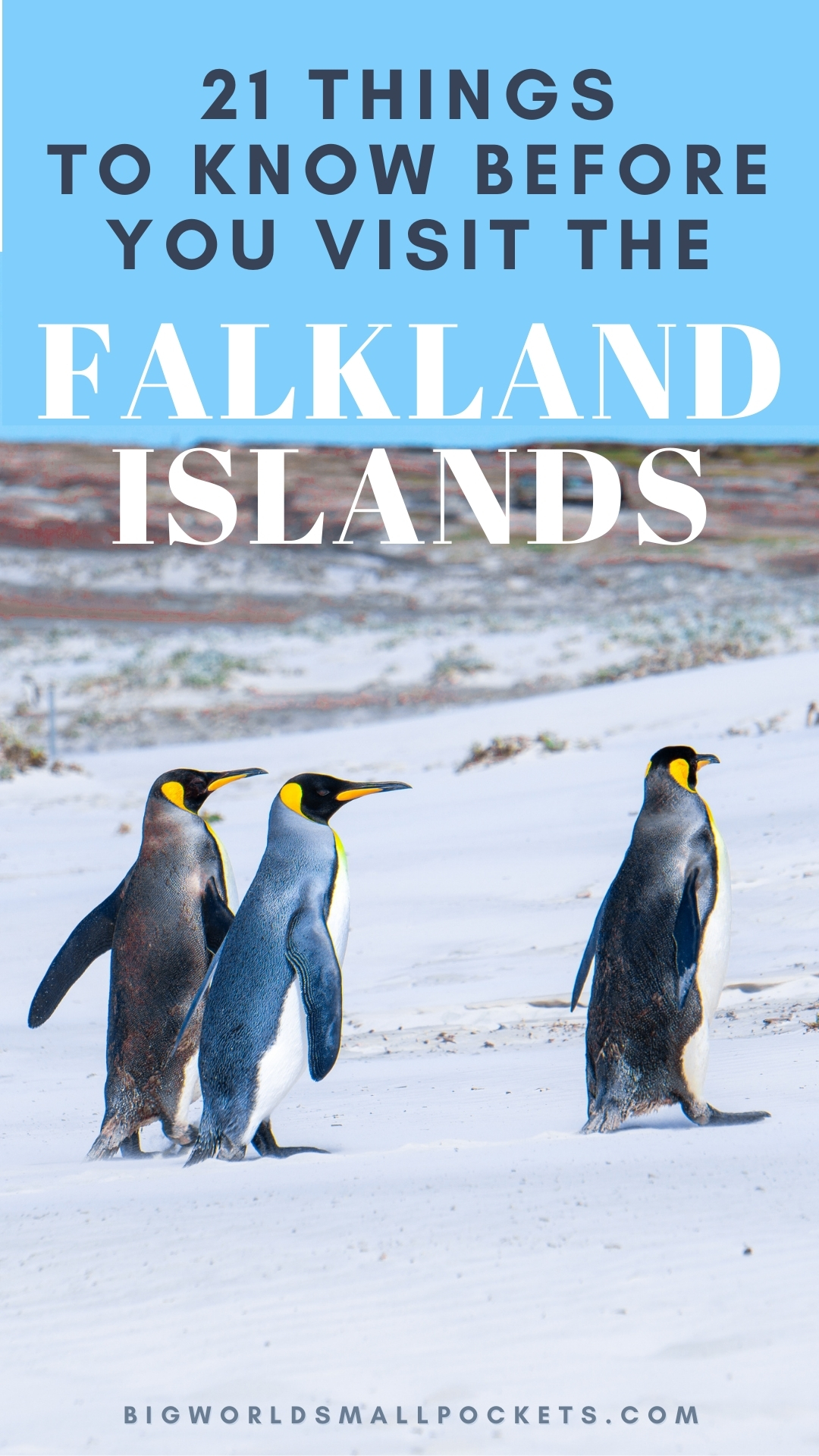I think it’s pretty fair to say, there isn’t much practical info online about visiting the Falkland Islands!
In fact, when I was planning my trip there it was almost impossible to easily discover many of the barebones facts of what it takes to plan a trip there, especially if you’re trying to visit this amazing archipelago independently.
Which is exactly why I’m bringing you this post – hoorah!
Filled with all the info needed to prep your visit to the Falkland Islands, these 21 things to know cover all aspects of your travels there, including the best time to visit, how long to spend there, what to do when you’re there, where to stay and what to expect.
I hope you find it useful!
Related Posts
- Top 13 Things to Do in the Falkland Islands
- All You Need to Know about Travel to Sea Lion Island, Falklands
- 20 Best Things to Do in Stanley, Falkland Islands
Planning a Falkland Trip
#1 Best Time to Visit
The best time to visit the Falkland Islands is definitely during their spring or summer season, which falls between the months of November and March.
This is when the weather is at its most travel friendly (i.e. you’ll get the least flight disruption!) and it’s the breeding season for many of the island’s top wildlife populations – which means you’ll get the best sightings and snaps of the animals too.
#2 How Long to Spend There?
I suggest you spend at least 7 days in the Falkland Islands to get a good flavour of this incredible destination.
If you can afford 2 weeks, even better!
Because of the limited flights to the islands – see below – it’s often better to plan your trip in week-long slots (to fit the flight patterns).
While this will allow you to spend 7 full days on the islands, don’t forget to factor in a minimum of 2 days either side of your time there for travel to and from you home country.
This means most trips to the Falkland Islands will last a duration of 11 days in total – 2 days travel there, 7 days on island, plus 2 days travel back.
#3 Ideal Falkland Itinerary
If budget allows, I really recommend getting out of Stanley to experience many of the smaller islands, as this is where the best wildlife and remote Falkland experiences can be enjoyed.
Anywhere outside of Stanley in known as “camp” in the Falklands, and you’ll hear this expression a lot!
1-2 nights on each outer island is a good shout.
The number of islands you plan to visit will largely depend on 2 factors…
- your trip budget
- lodge availability
This is because, with limited accommodation on most of the outer islands, things are both expensive and get booked up early.
Outside of that, I’d plan to have at least the first and last night of your Falkland trip in Stanley to ensure damage limitation to your plans in the case of disruptive weather.
#4 Money & Currency
The Falklands, as an overseas British territory, use Pound Sterling as their currency.
They do however, have their own notes and coins with Falkland imagery.
Falkland notes and coins can only be used in the Falklands, but you can use traditional sterling anywhere here.
If you’ve been to Jersey in the Channel Islands (where I grew up!), it’s a similar thing!
Most places in the Falklands, however, allow you to pay on card, so you don’t even really need much cash.
If you do find yourself in an emergency, then there’s one bank on the Falkland Islands in Stanley.
It has an ATM.
#5 Climate & Weather
The Falkland Islands lie in the South Atlantic off the coast of southern South America.
In relative terms, the islands are not that far from the Antarctic Peninsula!
This means they get some pretty wild weather and things definitely shift quickly out here.
In the winter (from May to Sept) the islands are cold and wet and grey.
Average temperatures are only around 2 degrees Celsius at this time and, although they do dip below zero especially at night, snow is not that common in the Falklands, given its generally low-lying terrain and plethora of the sea and salt air.
Weather patterns however, do play havoc with travel, so many lodges and tourism services shut down during the winter months here.
In the summer (from Nov to Mar), the islands are warmer and drier, but still only hover at an average of around 10 degrees Celsius.
Blue skies days are common, but the wind picks up something crazy, so you’ll still want to bring plenty of warm clothing layers!
#6 What to Pack & Travel Insurance
And on that note, we’ll segue perfectly into what to pack for the Falkland islands!
Almost everyone will visit this archipelago during the summer, so this complete Falkland packing list I wrote covers everything you need to bring for travel in that season.
If you’re looking for a short hand version however, then it’s hiking boots, warm socks, windproof jacket, good base layers, sunglasses, sunscreen, decent camera, warm hat and gloves, active trousers, fleeces and a good daypack.
When it comes to insurance, World Nomads offers simple and flexible travel insurance. Buy at home or while travelling and claim online from anywhere in the world.
Alternatively, if you’re a long-term traveller, digital nomad or frequent remote worker seeking travel health cover, check out Safetywing’s Nomad Insurance policies.
#7 Wifi & Data
Sure are the network providers in the Falklands and while they do have roaming agreements with some UK providers, such as Vodafone, it’s incredibly expensive to use your phone or data connection here,
So too is wifi connection in the Falklands, so don’t expect any accommodation or cafe you visit to have free wifi!
Your best bet in the Falklands is to buy some of Sure’s wifi cards, which can be scratched off to reveal a code that allows you internet access at island wifi hotspots.
Most settlements and hotels here have these hot spots.
Wifi cards are available in £5 or £10 denominations and available at most shops and the tourism office in Stanley, as well as lodges in camp.
The £5 card will give you 50 minute of consecutive wifi access, so get your value for money by logging on and checking emails, social and Whatsapp all at once!
The wifi thing is a bit of a nightmare in the Falklands, so I suggest you see it as digital detox trip and embrace that.
Personally, I loved being almost entirely offline for a week – it was a real treat and allowed me to enjoy this amazing remote location even more.
Travelling to the Falkland Islands
#8 Visas for the Falklands
As a British Overseas Territory, you do not need a visa to enter the Falklands if you do not need a visa to enter the UK.
Conversely, if you do need a visa for the UK, you’ll need one for the Falklands too.
Regardless of where you’re from, even if you’re a British national, stays in the Falkland Islands are capped at 30 days, unless you have a permit to stay, live or work there.
Everyone must therefore travel to the Falklands with a valid passport, that has at least 6 months of remaining validity and 1 blank page.
This is because you’ll receive a stamp when you enter and exit the Falklands (at the airport immigration point), which shows the amount of time spent there.
The best thing about this stamp is that it has a penguin on it!
#9 Flying to the Falklands
There’s 2 main routes you can use to fly to the Falklands.
An MOD route direct (ish) from the UK and a commercial route with LATAM via Chile.
There’s a lot of info to take in about these quite peculiar flight options, so I’ve written a huge post about flights to the Falklands you can check out for more info.
Otherwise, the key things to know are that you need book early, pay a lot and expect disruptions!
I might not be selling it, but trust me, the effort to get to the Falklands is MORE than worth it!
#10 Cruising / Sailing to the Falklands
The other way many people visit the Falklands is as part of a cruise or sailing boat – usually an epic voyage through Patagonia or on to South Georgia and Antarctica, if you’re looking to take in the Falklands as part of a longer voyage of discovery in the South Atlantic region, check out these fantastic options.
Arriving in the Falklands
#11 Mount Pleasant Airport
If you’re arriving by plane to the Falklands, you’ll land at the International Airport, which is located in Mount Pleasant.
It operates as both a commercial and military airport, run by the UK Defence Force.
This makes it pretty unique!
In particular, you’ll see a heavy police presence here, you’ll also have to queue for a long time, as baggage facilities are pretty limited.
You’ll have to pass through immigration, get your stamp and fill in a form, as well as clear a bio-security check point.
All this can take a long time, so expect to spend at least 1-2 hours at Mount Pleasant Airport to clear all formalities after landing!
On the flip side, as you depart the islands, you’ll also have to get there around 4-5 hours before your flight for the reverse formalities, so don’t plan too much on your last day here!
You’ll also need to pay a departure tax when leaving the islands too.
#12 Getting to Stanley
It’s about a 90 minute drive from Mount Pleasant Airport (MPA) to the capital of Stanley.
As there’s only max 3 flights a week landing in the Falklands, it’s easy to group shuffle travellers between the 2 places.
After all, you should not expect taxis to be at the airport, or any public transport!
Instead, you’ll need to speak to your accommodation, either about getting a lift or, more likely, being booked on the coach that shuttles pretty much everyone from the airport and then drops them off at their registered accommodation in the capital.
This is the easiest and cheapest way to get to Stanley, although not the quickest because you have to wait for everyone to clear airport formalities before you depart!
#13 Bio Security
At the airport, you’ll pass bio security.
This will likely involve you having to stand in a tub of disinfectant and also have your luggage checked for any fresh produce or your boots and tents checked for mud, seeds etc.
This is to protect the unique ecosystem and wildlife of the Falkland Islands, particularly from Avian Flu.
There are also biosecurity points on each of the smaller islands when you fly to them.
Usually these are disinfectant tubs outside the lodges.
Make sure you use them and always scrub down your boots well too.
Getting Around the Falklands
#14 Car Rental
It is possible to rent cars on the Falklands from a couple of small, local firms, such as Moody Enterprises Vehicle Hire.
These companies are based in Stanley, so you’ll have to travel there to collect the vehicle and compete the paperwork.
As a heads up, car rental is only really useful if you’re staying on East Falkland, as you can’t take vehicles to the smaller islands – you have to fly there.
You may be able to take your rental car to West Falkland, via the ferry from New Haven to Port Howard, as they do allow vehicles, but do check this with your hire firm first.
You’ll also need to check where you can drive with your rental car.
If it’s gravel roads only, you will be limited even in East and West Falkland!
If you need a taxi in the Falklands instead, contact Letty Taxis.
#15 Falklands Ferry
As I mentioned above, there is a ferry service that runs between the 2 main islands of East and West Falkland.
Cheaper than flying between the 2 islands, the ferry runs a few times a week and takes around 90 – 120 mins.
The service is operated by Workboat Services Ltd, who use the MV Concordia for the journey.
Both foot passengers and vehicles need to book in advance.
The ferry is a great option for those wanting to explore the Goose Green and Darwin, as well as Port Howard areas of the 2 islands – but do remember it can take several hours to drive from there to other spots on both East and West Falkland such as Stanley or Hill Cove.
If you’re looking to get around efficiently and see as much as possible, flying is the better option.
#16 Using FIGAS
Which leads me on nicely to talking about FIGAS.
Standing for the Falkland Islands Government Air Service, this incredible network transports passengers and freight around the islands every day from dawn until dusk.
With landing strips in most settlements across the Falklands (i.e. where people live), you can use this service to get almost anywhere.
You just have to book and pay in advance for a certain route on a certain day and then wait to hear your flight time the day before.
This info is available on the radio on via the FIGAS Facebook page.
It’s quite an amazing system and you can learn all about my experience of it, as well as how to book and sort flights yourself in this article I wrote.
#17 Taking Tours
You can also use tours to get around the islands and explore more deeply.
Particularly helpful if you’re journeying around the Falklands independently, tours as a great way to visit places with locals and learn more about their life, the islands and the flora and fauna.
Tours also allow you to get places that some pretty heavy duty 4WD skills are required!
Tours are available on most of the smaller islands (especially Pebble and at Hill Cove), as well as on the main islands of East and West Falkland.
If you want to see some of the great wildlife spots around Stanley – like Volunteer Point or Kidney Island – or you want to learn more about the history of 1982 conflict here and visit some of the memorial sites, tours are a great idea.
Check out these recommended tour guides.
#18 Access Permit on the Falklands
Guides are also useful when exploring the Falklands because they tend to secure access permits for you.
And permit access is required for just about anywhere is the Falklands, as pretty much the whole archipelago is privately owned.
This means to visit places without tours, especially on the main islands, if you want to go hiking, war memorial finding, penguin spotting or anything else, you’ll need a permit from the land owner.
Don’t just expect to rock up on the day and be granted one either (or even find anyone to talk to!) – this all needs to be arranged well in advance.
Landowners need to be called and paid.
You can find their details through the Tourism Office, but just a heads up, this all takes time!
The only place you don’t need permits are the self-guided trails around Stanley, as these are on government-owned land.
Details of the trails can be found on leaflets available from the Tourism Office by the jetty in Stanley.
Staying & Eating in the Falklands
#19 Falklands Accommodation
There’s 2 main types of accommodation across the Falkland Islands:
- purpose built hotel and lodges
- farmhouses or homes that have been converted into guesthouses or self-catering spots
Across most of the more popular small islands, such as Pebble Island and Sea Lion Island, lodges are available and offer fantastic homely accommodation that is specifically designed for tourists.
They generally include 3 meals a day, transfer from the landing strip, free tea and coffee daily, afternoon cake, as well as maps and info about the island.
Many also offer tours to guests to see the wildlife etc.
In Stanley, there’s a couple of purpose built hotels, namely the Malvina House Hotel and the Waterfront Boutique Hotel.
The other type of accommodation on the Falklands are conversions.
Tu Guesthouse in Stanley is a great example of this, where locals have turned their home into an accommodation provision.
Elsewhere there are self-catering spots at Hill Cove, Darwin & Goose Green, Fox Bay, Saunders Island and Weddell Island.
Hill Cove also boasts the Falkland’s first glamping cabin – Boxwood Pod.
You can read about my time there.
#20 Food
Most of the food in the Falklands (outside of lamb, some dairy and few vegetables) has to be shipped in.
This means it can be very pricey and choices can be limited.
To be fair, I think it’s an ok price to pay if you want to travel this remotely!
There’s 2 supermarkets in Stanley where you’ll need to stock up for self-catering.
I wouldn’t count on any other stores anywhere else across the archipelago!
There’s also a few good restaurants and cafes in Stanley – I tried Groovy’s and the Teaberry Café. Both did the job.
The best restaurant in town is thought to be either at the Malvina House Hotel or at the Waterfront Boutique Hotel.
On the smaller islands, the lodges will provide you with 3 meals a day usually, which is the easiest option!
I’m a vegetarian and I more than survived on the islands.
Just don’t come expecting gourmet food!
#21 Drinking
In Stanley there’s a number of good pubs – from classic English pub, The Victory, through to the fancy new wine bar Unwined and the craft brewery Beerworks.
There’s also a local gin distillery located by the Tourism Office.
Both the distillery and Beerworks are well worth checking out to sample the local tipples and to tipple with the locals!
Alcohol is very cheap in the Falklands, as there’s no alcohol tax, but if you want to get up early for all those wildlife sunrise shots, it’s best not to overindulge!
Most of the island lodges have honesty bars, so you can enjoy a glass of wine with dinner here.
Alcohol isn’t included in the lodge rates and can be paid on departure using cash or card.
PIN IT TO PINTEREST!
So there you have it, my full guide to the 21 things you need to know before you visit the Falkland Islands.
I hope the info was helpful and I’ve convinced you to head to this stunning spot!
Still have questions about travelling here?
Don’t hesitate to drop them into the comments box below and I’ll get back to you…
My trip to the Falkland Islands was kindly sponsored by Falkland Island tourism but, as always, all views are my own.
This page contains affiliate links meaning Big World Small Pockets may receive a small commission on any purchases at no extra cost to you.

